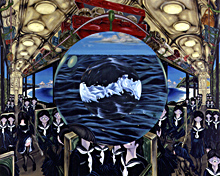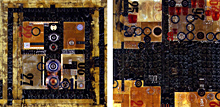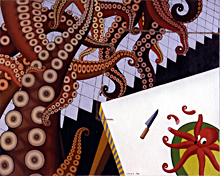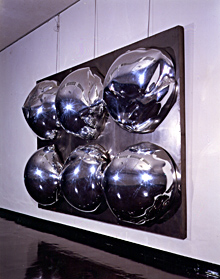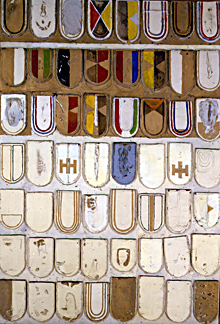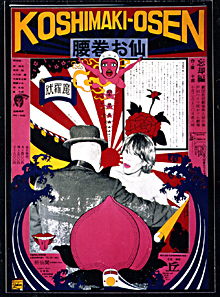3d
日本のポップ・アート
Pop Art in Japan
【本文確定】
1964年1月、「ヤング・セブン」展という、いかにもアメリカ的なタイトルの展覧会が東京のコマーシャルギャラリー、南画廊で開催されました。若い7名の作家とは、荒川修作、菊畑茂久馬、工藤哲巳、三木富雄、中西夏之、岡本信治郎、立石紘一[のちの立石大河亞]でした。本展を企画した評論家の東野芳明は、「商業的な画廊で、運動とは切り離された形で、作品として一応客観的に展示された」と言いました*3d1。そういえば美術界ではしばらくの間、ネオ・ダダ等の前衛運動集団が、読売アンデパンダン展などを舞台に、タブロー性や商業性を拒否し続けてきたのでした。「ヤング・セブン」展で示された傾向、すなわち(1)個々人による、(2)形態のはっきりした、(3)タブロー作品といったような特質が、広義の日本のポップ・アートの属性です*3d2 *3d3。
驚異的な高度成長のただ中でした。評論家のヨシダ・ヨシエによれば、「六四年からの海外渡航の自由化、テレビ映像の日常化をはじめとする情報化社会の幕あけは、占領下の体験を布石に、アメリカのリアリティが日本のリアリティであるかのように錯覚され、ふたたびアメリカ、ヨーロッパ文化への傾斜度を深め」たとのことです*3d4。美術界ではこの1964年にジャスパー・ジョーンズ、ロバート・ラウシェンバーグが初来日し、アメリカの影響が強まりました。ロバート・ラウシェンバーグが、アメリカの国を挙げての支援によってヴェネツィア・ビエンナーレで大賞を勝ち取ったのも同じ1964年です。経済や軍事のみならず文化においても、アメリカが世界の覇者となりつつありました。日本の前衛美術家たちも雑誌等でニューヨークの最新動向を逐一入手していたため、前年の1963年には、ポップ・アートの語が日本でも知れ渡っていました。
日本のポップ・アートを前述した広義の意味にとらえ、なおかつ(4)世俗的、増殖的あるいは性的な傾向というふうに一応くくり、幾何学抽象から立体オブジェまで含めてみるならば、それは1950年代から連綿と制作され続けてきたといえます。本書では3通りに分類します*3d5。
一つ目は年長世代を含むグループです。靉嘔、村上善男、中村宏、岡本信冶郎、鶴岡政男、吉仲太造ほか、1950年代に登場したアンデパンダン作家第1世代や、ルポルタージュや密室の絵画の作家等も含みます。戦前から幾何学抽象を探求し1960年代に曼陀羅的なオプ・アートに至ったオノサトトシノブや、極めて独自でありながらポップ・アートやミニマル・アートとの同時代性も感じさせる草間彌生、さらには彫刻家の多田美波や篠田守男もここで挙げておきます。
二つ目は反芸術を推進した作家たちで、篠原有司男、吉村益信らネオ・ダダの元メンバー、ならびに周辺の三木富雄、小島信明、磯辺行久、清水晃ほか、あるいは菊畑茂久馬ら九州派の元メンバーたちです*3d6。篠原有司男と吉村益信はネオ・ダダの無作品性を通過したのちに、安定した作品形式に回帰しました。三木富雄や磯辺行久は最初から作品美学を捨てていませんでしたが、この頃に彼らのメインモチーフである「耳」や「ワッペン」に出会っています。篠原有司男のこの時期の作品、たとえば星条旗バックの画面からコカコーラ瓶を握りしめた石膏の手が突き出した「Drink More」(1963)や、淫靡な浮世絵の絵柄を巨大に引き延ばしどぎつい蛍光塗料で色分けした「花魁」(1966)には、当時のアメリカや自国日本に対する揶揄あるいは卑下等の複雑な感情が顕れています*3d7。
三つ目はより若い世代で、立石紘一[のちの立石大河亞]や谷川晃一ほか、グラフィカルな傾向の画家たちです。版画家の池田満寿夫や野田哲也もここで挙げておきます。また、デザインやイラストレーションの分野の横尾忠則、田名網敬一、宇野亜喜良、金子國義、合田佐和子らもここで挙げておきます*3d8。
1964年3月、若い立石紘一[のちの立石大河亞]は年長の中村宏に声をかけ、観光芸術研究所を創設しました*3d9。両名ともタブロー形式に固執する画家だったにもかかわらず、通常展示以外に前衛運動集団らしく野外や街頭でのパフォーマンスも行いました*3d10。たとえば同1964年10月の東京オリンピック開催直前、東海道新幹線の開通にあわせて実施された「路上歩行展」は、サラリーマンが行き交う東京駅前で両名がそれぞれ100号の油彩画を頭上高く手で掲げたまま徘徊するという、反芸術か正当芸術かよくわからない奇天烈な折衷となりました。
In January 1964, a show with a very American sounding title "Young Seven" was held at the Minami Gallery, a commercial gallery in Tokyo*3d1. The seven young artists were ARAKAWA Shusaku 荒川修作, KIKUHATA Mokuma 菊畑茂久馬, KUDO Tetsumi 工藤哲巳, MIKI Tomio 三木富雄, NAKANISHI Natsuyuki 中西夏之, OKAMOTO Shinjiro 岡本信治郎 and TATEISHI Koichi 立石紘一 [later to be known as Tiger TATEISHI 立石大河亞]. The critic TONO Yoshiaki 東野芳明 who curated the show described it as "works were exhibited as works, separately from movements, in mostly objective fashion at a commercial gallery." As this remark brings up, the art world had been occupied for a while by movements of avant-garde groups, such as Neo Dada at the Yomiuri Independent Exhibitions, that rejected tableaus or commercialism. "Young Seven" showed a counter tendency towards tableaus with clear shape and form, which is pop art in Japan in a broad sense*3d2.
It was the midst of the miraculous rapid economic growth. According to the critic YOSHIDA Yoshie ヨシダ・ヨシエ, "the dawn of the information era, beginning from the lifting of travel restrictions since 1964 and the daily exposures to the TV images, moulded past experiences of the occuption by the USA into an illusion as if the reality of the USA has become the Japanese reality, deepening the tendencies towards American and Enropean culture again."*3d3 In the art world, Jasper Johns and Robert Rauschenburg came to Japan for the first time in this 1964, which strengthened influence of the USA in Japan. It was also in 1964 when Robert Rauschenburg, fully supported by the backing from the state, won the grand-prix at la Biennale di Venezia. The USA was becoming the world power in not only economic and military but also cultural aspect as well. Japanese avant-garde artists also collected the latest trends in New York from magazines, and the word Pop Art was broadly recognized already in the previous year 1963.
Pop art in Japan can be seen to have been produced continuously since the 1950s, if taken in a broad sense of the word, categolized tentatively as tending to be worldly, multiplicative or erotic, and included with geometric abstraction and object. This book will categolize pop art in Japan into following three segments*3d4.
The first is the senior generations, which includes AY-O 靉嘔, MURAKAMI Yoshio 村上善男, NAKAMURAa Hiroshi 中村宏, OKAMOTO Shinjiro 岡本信冶郎 or YOSHINAKA Taizo 吉仲太造, as well as artists in the 1950s such as the first generation of the Independent Exhibition artists, reportage painters or those of closed-door painting. Adding to them, this category also include ONOSATO Toshinobu オノサトトシノブ who produced Mandara-like op art in the 1960s after having explored geometric abstraction since before the World War II, KUSAMA Yayoi 草間彌生 whose idiosyncratic works simultaneously suggest contemporaneity with pop art or minimal art, or the sculptors TADA Minami 多田美波 and SHINODA Morio 篠田守男.
The second is the anti-art generation, which includes the former Neo Dada members like SHINOHARA Ushio 篠原有司男 or YOSHIMURA Masunobu 吉村益信, as well as those around Neo Dada like MIKI Tomio 三木富雄, KOJIMA Nobuaki 小島信明, ISOBE Yukihisa 磯辺行久, SHIMIZU Akira 清水晃, and the former members of Kyushu-ha such as KIKUHATA Mokuma 菊畑茂久馬*3d5. Having experienced Neo Dada's undoing works of art, SHINOHARA Ushio 篠原有司男 and YOSHIMURA Masunobu 吉村益信 turned towards works using stable materials. Although MIKI Tomio 三木富雄 and ISOBE Yukihisa 磯辺行久 never really gave up on the aesthetics of works of art, it was around this time when they came across their main motiefs, the ear and emblem. Works by SHINOHARA Ushio 篠原有司男 at around this time show an ambivalent emotion towards the USA and Japan at that time, such as "Drink More" (1963), a plaster hand holding a coca-cola bottle against the stars and stripes behind, or "Oiran" (1966), an enlarged erotic ukiyo-e pattern with its colors re-painted in gaudy fluolescent ones*3d6.
The third is younger generations, who are painters leaning towards more graphical approachs, such as TATEISHI Koichi 立石紘一 (later to be known as Tiger TATEISHI 立石大河亞), TANIKAWA Koichi 谷川晃一 and others. The printmakers IKEDA Masuo 池田満寿夫 and NODA Tetsuya 野田哲也 also can be mentioned here, as well as those in the fields of design and illustration such as YOKOO Tadanori 横尾忠則, TANAAMI Keiichi 田名網敬一, UNO Akira 宇野亜喜良, KANEKO Kuniyoshi 金子國義 and GODA Sawako 合田佐和子.
In March 1964, the young TATEISHI Koichi 立石紘一 (later to be known as Tiger TATEISHI 立石大河亞) called upon his senior NAKAMURA Hiroshi 中村宏 to launch KANKO GEIJUTSU KENKYUJO (Sightseeing Art Institute)*3d7. Although both of them were painters adhering to paintings on tableaus, they also carried out street and outdoor performances aside from the usual exhibitions as if an avant-garde movement group*3d8. For example, "Street Walking Exhibition," which was held in October of the same year 1964 just before the Tokyo Olympic and at the same time as the opening of Tokai-line bullet train, involved the two wandering about in front of the Tokyo Station crowded with business men while holding up no.100 oil paintings over their heads, resulting in a weird mixture unidentifiable to either art or anti-art.

